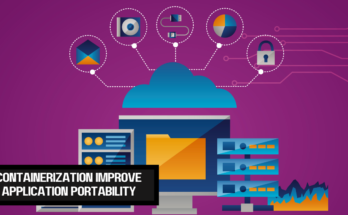The Evolution of IT in Business Management
Introduction:
Within the ever-evolving corporate world, information technology (IT) has emerged as a powerful force for expansion and transformation. Technology is becoming an essential component of managing a company, helping with decision-making and operational optimization. This article explores the intricate role that IT plays in modern corporate management, shedding light on the strategies used by businesses to stay resilient and competitive in today’s fast-paced industry.

1.Efficiency and Streamlining Operations:
IT in Business brings cutting-edge software solutions that completely transform the way companies run their operations. These systems are made to manage complicated jobs, automate time-consuming procedures, and provide easy data administration. This lowers the possibility of human error while also guaranteeing precision and consistency across a range of operational aspects.
- Automation Tools: One of the main ways that IIT in Business improves management efficiency is through automation. Organizations can do away with manual intervention in repetitive and time-consuming operations by implementing automation systems. This expedites procedures while freeing up human resources to concentrate on jobs requiring innovation and critical thought.
- Enterprise Resource Planning (ERP) Systems: ERP solutions are essential for combining and unifying various corporate operations. ERP systems facilitate smooth departmental communication and collaboration by offering a consolidated platform for data management. As a result, there is less duplication, better coordination, and more effective resource allocation.
- Customer Relationship Management (CRM) Software: CRM software is revolutionary for firms where customer interactions are the main focus. IT in Business makes it easier for businesses to deploy CRM solutions, which improves customer relationships and lets them manage customer data and interactions. This helps to create a more individualized and successful approach to customer engagement in addition to streamlining customer-centric procedures.
- Supply Chain Management Tools: IT provides technologies that optimize the movement of information and goods in the context of logistics and supply chain activities. Businesses may reduce lead times, get real-time visibility into their supply chains, and react quickly to demand changes by integrating supply chain management systems. This raises overall supply chain resilience as well as operational efficiency.
2.Data-Driven Decision Making:
In the contemporary business landscape characterized by the proliferation of big data, organizations find themselves immersed in a sea of information. The integration of Information Technology (IT) emerges as a pivotal force, serving as the catalyst to harness this wealth of data and transform it into actionable insights. This paradigm shift is instrumental in redefining how businesses make decisions, emphasizing a transition towards a more data-centric approach.
Harnessing Data:
Businesses today create and gather enormous amounts of data from a variety of sources, including transactions, consumer interactions, and internal operations. IT in Business infrastructure makes it easier to gather, store, and interpret this data in an organized manner, preventing important insights from being lost in the deluge of data.
Conversion to Actionable Insights:
In order to transform data into tangible knowledge that can direct strategic decision-making processes, IT plays a particularly important role in transforming raw data into meaningful and actionable insights. Cutting-edge analytical tools and algorithms assist in interpreting patterns, trends, and correlations within the data.
Business Intelligence Tools:
Using Business Intelligence (BI) technologies is a defining feature of IT’s role in supporting data-driven decision-making. These tools include a variety of programs made to extract, examine, and display data. Managers can obtain a thorough grasp of important performance metrics, new trends, and possible areas for improvement by utilizing the dashboards and reports produced by business intelligence (BI) solutions.

Real-time Analytics:
Businesses can leverage IT to enable real-time analytics, giving decision-makers access to the most recent data. Being nimble is crucial in a hectic work setting as it allows for prompt reactions to shifts in the market, client preferences, and internal dynamics.
Forecasting Trends:
A branch of data-driven decision-making called predictive analytics helps businesses project future trends by using past data and current tendencies. Businesses can proactively position themselves to take advantage of opportunities or reduce risks by anticipating possible developments.
Identifying Areas for Improvement:
IT helps managers identify areas in the firm that could use improvement by providing data-driven insights. Data-driven decision-making offers a path forward for focused improvements, be it improving customer experiences, streamlining operational procedures, or expanding product options.
Enhancing Strategic Planning:
The strategic planning process is significantly improved by the incorporation of IT into data-driven decision-making. Decision-makers can develop plans based on a thorough understanding of current market conditions and future projections, creating a more informed and forward-thinking attitude, as opposed to depending solely on intuition or historical precedent.
Adaptability in a Dynamic Environment:
The use of IT in data-driven decision-making greatly enhances the strategic planning process. Rather than relying just on gut feeling or past performance, decision-makers can create more informed and forward-thinking plans by thoroughly comprehending current market conditions and future projections.
3.Enhanced Communication and Collaboration:
- Critical Role of Effective Communication: Unquestionably, the cornerstone of any organization’s success is effective communication. Fostering a collaborative work atmosphere, guaranteeing understanding, and aligning teams all depend on timely, clear communication.
- Seamless Connectivity Across Geographical Boundaries: The use of information technology is essential in removing geographical obstacles that previously impeded communication. Teams that are dispersed over several places may now easily connect and work together in real time thanks to IT solutions, which increases production and efficiency.
- Diverse Toolkit for Communication: IT offers a wide range of communication tools that go beyond conventional techniques. Email was once a ground-breaking tool for communication, but systems for video conferences, project management, and collaboration have replaced and enhanced it. Together, these resources give teams the flexibility to communicate in ways that best fit the demands of the current project.
- Revolutionizing Business Operations: The way organizations function has been completely transformed by the incorporation of IT tools. Email makes it easier to communicate asynchronously, video conferencing allows people to meet in person, project management tools guarantee a well-organized workflow, and collaborative platforms promote teamwork. The combination of these instruments creates a company environment that is more responsive and nimble.
- Breaking Down Silos: Organizational systems have historically facilitated the development of silos, which have impeded efficient departmental communication. By offering platforms that make it simple for teams to communicate and access information, IT helps to break down these silos. This promotes a feeling of cohesion and a common goal in addition to enhancing communication in general.
- Promoting a Culture of Transparency: An effective corporate culture is built on transparency. Through the provision of a consolidated platform for information exchange, updates, and progress reports, IT systems facilitate transparent communication. This openness fosters confidence between team members and the leadership, fostering a cooperative environment where everyone is knowledgeable.
- Encouraging Teamwork: In today’s business world, collaboration is not just a buzzword—it is essential to success. By offering resources that allow for shared access to resources, cooperative decision-making, and simultaneous project contributions, IT promotes and supports teamwork. The team’s combined experience promotes creativity and problem-solving in this cooperative manner.
4.Innovation and Competitive Advantage:
Technological Leverage: Businesses may fully utilize the potential of cutting-edge technologies like blockchain, artificial intelligence (AI), and the Internet of Things (IoT) by integrating IT in Business management. By using state-of-the-art tools in a proactive manner, businesses may not only adjust to changing circumstances but also set the standard for technological innovation in their particular sectors.
Staying Ahead of Industry Trends: Utilizing IT in Business management enables companies to keep ahead of changing market trends. Through constant observation and integration of emerging technological innovations, companies can establish themselves as leaders in their industry. This proactive approach not only increases their market relevance but also lays the groundwork for long-term, steady growth.
Gaining a Competitive Edge: Using IT-driven innovation to its full potential becomes essential to achieving a competitive edge. Businesses that successfully incorporate technology into their company plans are in a better position to provide distinctive and cutting-edge goods and services. This uniqueness strengthens the company’s position in the market by drawing in clients and posing a barrier to entrance for rivals.
Enhancing Products and Services: The improvement of goods and services is just one aspect of how IT in Business affects business management. Organizations are able to improve and enhance the caliber of their services with the use of technological breakthroughs. This guarantees that the company stays in the forefront of providing value in a market that is constantly changing while also satisfying the changing expectations of the clientele.
Opening New Revenue Streams: Innovation powered by IT in business management creates new opportunities for making money. Through the exploration and utilization of technology trends, enterprises can expand the range of goods or services they offer. This diversification adds to the organization’s overall financial resilience by shielding it from market swings and generating other revenue streams.
Revolutionizing Business Models: Beyond small tweaks here and there, IT integration into business management transforms entire business models. Businesses that adopt IT can restructure their customer relationships, operations, and value propositions. This flexibility guarantees that the company will always be flexible and nimble in the face of changing consumer demands, which creates the foundation for long-term success.

5.Cybersecurity Challenges:
- Protecting Sensitive Customer Data: With businesses depending more and more on digital platforms for a range of interactions and transactions, protecting sensitive consumer data becomes critical. Cybercriminals use this kind of data to further their harmful goals, so strong cybersecurity measures are needed to prevent unwanted access and any breaches.
- Safeguarding Intellectual Property: Many firms rely heavily on intellectual property (IP), which includes trade secrets, unique technologies, and creative concepts. Intellectual property theft is more likely in the digital sphere, though. Strong cybersecurity measures are necessary to protect these priceless resources against theft, unlawful access, and compromise.
- Investing in Cybersecurity Infrastructure: Acknowledging the constantly changing threat landscape, companies must make substantial investments in cybersecurity infrastructure. This includes putting in place secure network protocols, utilizing cutting-edge technologies, and utilizing sophisticated encryption techniques to provide a strong defense against online attacks.
- Resilience Against Potential Attacks: Cyberattacks can take many different forms, from ransomware attacks and phishing scams to more complex Advanced Persistent Threats (APTs). Businesses need to take a proactive stance, updating and strengthening their IT systems frequently to stay one step ahead of cyber enemies and guarantee resilience against possible attacks.
- Continuous Monitoring and Threat Detection: Mechanisms for threat detection and ongoing monitoring are essential components of a strong cybersecurity plan. Companies should use advanced technology and systems that can spot unusual activity and quickly notify security teams of possible risks before they materialize into full-scale attacks.
- Employee Training and Awareness: One important contributing reason to cybersecurity problems in IT in business management is still human mistake. Comprehensive training programs that teach staff cybersecurity best practices should be a top priority for businesses. Staff members that possess enhanced awareness are more equipped to identify and address possible hazards, which strengthens the overall cybersecurity posture.
6.Adaptability to Change:
The business environment is always changing, and IT in Business gives companies the means to quickly adjust to these changes. For example, cloud computing enables companies to scale up or down operations in response to demand, thereby enhancing flexibility and reducing costs. Agility afforded by IT in Business is essential for companies looking to take advantage of new opportunities and manage uncertainty.
Conclusion:
Finally, because IT provides so many tools and capabilities that improve productivity, decision-making, communication, and creativity, it has emerged as the central component of contemporary company management. Businesses need to be aware of the cybersecurity risks that come with integrating IT, even though the advantages of IT in business management are great. The future of IT in Business management is expected to bring with it both new opportunities and problems for companies looking to prosper in the digital age as long as technology continues to improve.
FAQs: The Evolution of IT in Business Management
Q: How has role of IT in business management?
From strategic partner to automation: Early IT was primarily concerned with data input and accounting automation. IT in business management now serves as a strategic partner, promoting creativity, streamlining procedures, and facilitating data-driven decision-making.
Q: What are some key milestones in this evolution?
Large amounts of data were processed by centralized computers for payroll and inventory management during the mainframe era (1950s–1970s). Departmental and employee power rose with the personal computing revolution of the 1980s and 1990s. Networking and the internet changed communication and data interchange in the 1990s and 2000s, enabling e-commerce and international cooperation. 2010 saw a significant transformation of business procedures and consumer relations with the introduction of mobile and cloud computing technology. The big data and AI frontier of the 2020s and beyond is influencing business decision-making, personalized experiences, and predictive analytics.
Q: What are the benefits of IT in business management?
The organization has increased production and efficiency by automating jobs, optimizing workflows, and improving information accessibility. This has improved decision-making, improved customer engagement, raised competitiveness, and expanded globally. IT in business management has also made it possible to collaborate and communicate easily while adjusting to changes in the market and making the most use of available resources.
Q: What are some challenges businesses face with IT integration?
Here are some challenges businesses face with IT integration:
- Cybersecurity challenges: Safeguarding sensitive data and countering cyberattacks demands ongoing vigilance and investment.
- Skill shortage in digital proficiency: Insufficient workforce expertise in managing and leveraging IT effectively.
- Tech evolution hurdles: Adapting business processes to keep abreast of continuous technological advancements.
- Integration complexities: Effortlessly incorporating new technologies into existing systems and infrastructure.
- Ethical responsibilities: Ensuring the responsible use of data, AI, and automation to prevent bias and privacy concerns.
Q: What does the future hold for IT in business management?
The future hold for IT in business management:
- Automation is driven by AI: simplifying complex activities, stimulating human creativity, and improving strategic thinking.
- Customized encounters: adjusting interactions, services, and goods to suit the unique requirements and preferences of each client.
- IT and edge computing synergy: Merging physical devices with IT, ensuring real-time data analysis for optimal operations and logistics.
- Blockchain transparency: Securing and transparently recording financial transactions, supply chains, and diverse applications.
- AR/VR evolution: Revolutionizing employee training, product development, and enriching customer experiences.

